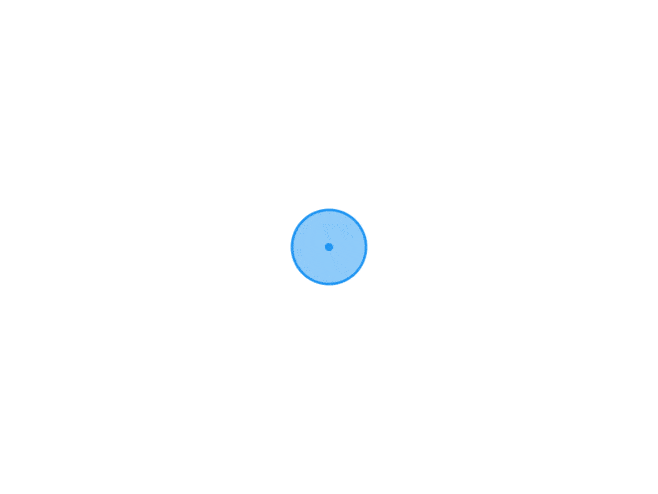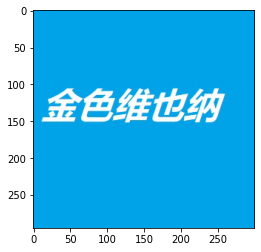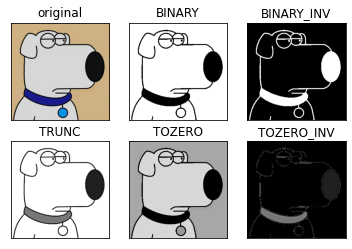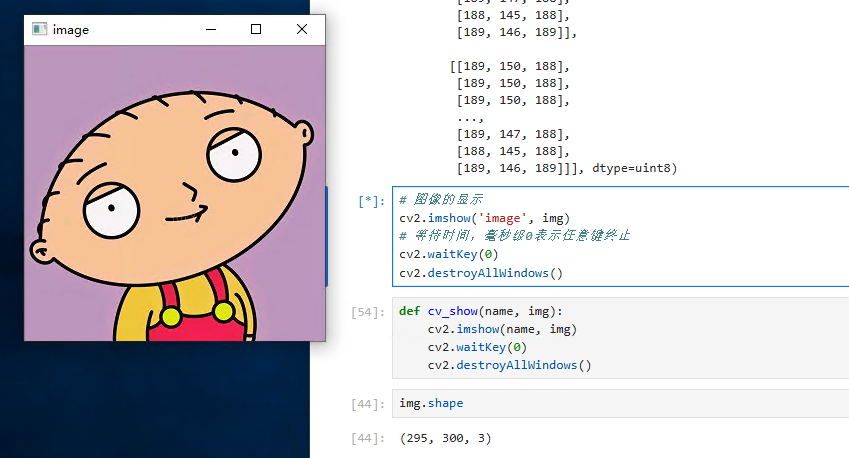搜索到
4
篇与
的结果
-
 四、图像形态学操作 1. 腐蚀操作import cv2 # OpenCV 读取的格式是 BGR import matplotlib.pyplot as plt import numpy as np %matplotlib inlineimg = cv2.imread('jswyn.jpg') # cv2.imshow('img', img) # cv2.waitKey(0) # cv2.destroyAllWindows() plt.imshow(cv2.cvtColor(img, cv2.COLOR_BGR2RGB))<matplotlib.image.AxesImage at 0x2917d142438>kernel = np.ones((3, 3), np.uint8) erosion = cv2.erode(img, kernel, iterations=2) # cv2.imshow('erosion', erosion) # cv2.waitKey(0) # cv2.destroyAllWindows() plt.imshow(cv2.cvtColor(erosion, cv2.COLOR_BGR2RGB))<matplotlib.image.AxesImage at 0x2917e451dd8>yuan = cv2.imread('yuan.jpg') # cv2.imshow('yuan', yuan) # cv2.waitKey(0) # cv2.destroyAllWindows() plt.imshow(cv2.cvtColor(yuan, cv2.COLOR_BGR2RGB))<matplotlib.image.AxesImage at 0x2917df154a8>kernel = np.ones((3, 3), np.uint8) erosion_1 = cv2.erode(yuan, kernel, iterations=1) plt.imshow(cv2.cvtColor(erosion_1, cv2.COLOR_BGR2RGB))<matplotlib.image.AxesImage at 0x2917e749828>erosion_2 = cv2.erode(yuan, kernel, iterations=2) plt.imshow(cv2.cvtColor(erosion_2, cv2.COLOR_BGR2RGB))<matplotlib.image.AxesImage at 0x2917e791048>erosion_3 = cv2.erode(yuan, kernel, iterations=3) plt.imshow(cv2.cvtColor(erosion_3, cv2.COLOR_BGR2RGB))<matplotlib.image.AxesImage at 0x2917e7caa58>2. 膨胀操作img = cv2.imread('jswyn.jpg') # cv2.imshow('img', img) # cv2.waitKey(0) # cv2.destroyAllWindows() plt.imshow(cv2.cvtColor(img, cv2.COLOR_BGR2RGB))<matplotlib.image.AxesImage at 0x2917e80f358>kernel = np.ones((3, 3), np.uint8) erosion = cv2.dilate(img, kernel, iterations=2) # cv2.imshow('erosion', erosion) # cv2.waitKey(0) # cv2.destroyAllWindows() plt.imshow(cv2.cvtColor(erosion, cv2.COLOR_BGR2RGB))<matplotlib.image.AxesImage at 0x2917fd32048>yuan = cv2.imread('yuan.jpg') # cv2.imshow('yuan', yuan) # cv2.waitKey(0) # cv2.destroyAllWindows() plt.imshow(cv2.cvtColor(yuan, cv2.COLOR_BGR2RGB))<matplotlib.image.AxesImage at 0x2917fd747b8>kernel = np.ones((6, 6), np.uint8) erosion_1 = cv2.dilate(yuan, kernel, iterations=1) plt.imshow(cv2.cvtColor(erosion_1, cv2.COLOR_BGR2RGB))<matplotlib.image.AxesImage at 0x2917fdcc438>erosion_2 = cv2.dilate(yuan, kernel, iterations=2) plt.imshow(cv2.cvtColor(erosion_2, cv2.COLOR_BGR2RGB))<matplotlib.image.AxesImage at 0x2917fecd6a0>erosion_3 = cv2.dilate(yuan, kernel, iterations=3) plt.imshow(cv2.cvtColor(erosion_3, cv2.COLOR_BGR2RGB))<matplotlib.image.AxesImage at 0x2917ff28320>3. 开运算与闭运算jswyn1 = cv2.imread('jswyn1.jpg') # cv2.imshow('jswyn1', jswyn1) # cv2.waitKey(0) # cv2.destroyAllWindows() plt.imshow(cv2.cvtColor(jswyn1, cv2.COLOR_BGR2RGB))<matplotlib.image.AxesImage at 0x2917df080b8># 开运算:先腐蚀,再膨胀 kernel = np.ones((5, 5), np.uint8) open = cv2.morphologyEx(jswyn1, cv2.MORPH_OPEN, kernel) # cv2.imshow('open', open) # cv2.waitKey(0) # cv2.destroyAllWindows() plt.imshow(cv2.cvtColor(open, cv2.COLOR_BGR2RGB))<matplotlib.image.AxesImage at 0x291410e8e48># 闭运算:先膨胀,再腐蚀 kernel = np.ones((5, 5), np.uint8) close = cv2.morphologyEx(jswyn1, cv2.MORPH_CLOSE, kernel) # cv2.imshow('close', close) # cv2.waitKey(0) # cv2.destroyAllWindows() plt.imshow(cv2.cvtColor(close, cv2.COLOR_BGR2RGB))<matplotlib.image.AxesImage at 0x2914114a860>4.梯度运算# 梯度运算:膨胀 - 腐蚀 img = cv2.imread('yuan.jpg') kernel = np.ones((5, 5), np.uint8) gradient = cv2.morphologyEx(img, cv2.MORPH_GRADIENT, kernel) # cv2.imshow('gradient', gradient) # cv2.waitKey(0) # cv2.destroyAllWindows() plt.imshow(cv2.cvtColor(gradient, cv2.COLOR_BGR2RGB))<matplotlib.image.AxesImage at 0x291412e8da0>5.礼帽与黑帽礼帽:原始输入 - 开运算结果黑帽:闭运算结果 - 原始输入# 礼帽 img = cv2.imread('jswyn1.jpg') kernel = np.ones((3, 3), np.uint8) top_hat = cv2.morphologyEx(img, cv2.MORPH_TOPHAT, kernel) # cv2.imshow('top_hat', top_hat) # cv2.waitKey(0) # cv2.destroyAllWindows() plt.imshow(cv2.cvtColor(top_hat, cv2.COLOR_BGR2RGB))<matplotlib.image.AxesImage at 0x291415164e0># 黑帽 black_hat = cv2.morphologyEx(img, cv2.MORPH_BLACKHAT, kernel) # cv2.imshow('black_hat', black_hat) # cv2.waitKey(0) # cv2.destroyAllWindows() plt.imshow(cv2.cvtColor(black_hat, cv2.COLOR_BGR2RGB))<matplotlib.image.AxesImage at 0x2914253fb00>
四、图像形态学操作 1. 腐蚀操作import cv2 # OpenCV 读取的格式是 BGR import matplotlib.pyplot as plt import numpy as np %matplotlib inlineimg = cv2.imread('jswyn.jpg') # cv2.imshow('img', img) # cv2.waitKey(0) # cv2.destroyAllWindows() plt.imshow(cv2.cvtColor(img, cv2.COLOR_BGR2RGB))<matplotlib.image.AxesImage at 0x2917d142438>kernel = np.ones((3, 3), np.uint8) erosion = cv2.erode(img, kernel, iterations=2) # cv2.imshow('erosion', erosion) # cv2.waitKey(0) # cv2.destroyAllWindows() plt.imshow(cv2.cvtColor(erosion, cv2.COLOR_BGR2RGB))<matplotlib.image.AxesImage at 0x2917e451dd8>yuan = cv2.imread('yuan.jpg') # cv2.imshow('yuan', yuan) # cv2.waitKey(0) # cv2.destroyAllWindows() plt.imshow(cv2.cvtColor(yuan, cv2.COLOR_BGR2RGB))<matplotlib.image.AxesImage at 0x2917df154a8>kernel = np.ones((3, 3), np.uint8) erosion_1 = cv2.erode(yuan, kernel, iterations=1) plt.imshow(cv2.cvtColor(erosion_1, cv2.COLOR_BGR2RGB))<matplotlib.image.AxesImage at 0x2917e749828>erosion_2 = cv2.erode(yuan, kernel, iterations=2) plt.imshow(cv2.cvtColor(erosion_2, cv2.COLOR_BGR2RGB))<matplotlib.image.AxesImage at 0x2917e791048>erosion_3 = cv2.erode(yuan, kernel, iterations=3) plt.imshow(cv2.cvtColor(erosion_3, cv2.COLOR_BGR2RGB))<matplotlib.image.AxesImage at 0x2917e7caa58>2. 膨胀操作img = cv2.imread('jswyn.jpg') # cv2.imshow('img', img) # cv2.waitKey(0) # cv2.destroyAllWindows() plt.imshow(cv2.cvtColor(img, cv2.COLOR_BGR2RGB))<matplotlib.image.AxesImage at 0x2917e80f358>kernel = np.ones((3, 3), np.uint8) erosion = cv2.dilate(img, kernel, iterations=2) # cv2.imshow('erosion', erosion) # cv2.waitKey(0) # cv2.destroyAllWindows() plt.imshow(cv2.cvtColor(erosion, cv2.COLOR_BGR2RGB))<matplotlib.image.AxesImage at 0x2917fd32048>yuan = cv2.imread('yuan.jpg') # cv2.imshow('yuan', yuan) # cv2.waitKey(0) # cv2.destroyAllWindows() plt.imshow(cv2.cvtColor(yuan, cv2.COLOR_BGR2RGB))<matplotlib.image.AxesImage at 0x2917fd747b8>kernel = np.ones((6, 6), np.uint8) erosion_1 = cv2.dilate(yuan, kernel, iterations=1) plt.imshow(cv2.cvtColor(erosion_1, cv2.COLOR_BGR2RGB))<matplotlib.image.AxesImage at 0x2917fdcc438>erosion_2 = cv2.dilate(yuan, kernel, iterations=2) plt.imshow(cv2.cvtColor(erosion_2, cv2.COLOR_BGR2RGB))<matplotlib.image.AxesImage at 0x2917fecd6a0>erosion_3 = cv2.dilate(yuan, kernel, iterations=3) plt.imshow(cv2.cvtColor(erosion_3, cv2.COLOR_BGR2RGB))<matplotlib.image.AxesImage at 0x2917ff28320>3. 开运算与闭运算jswyn1 = cv2.imread('jswyn1.jpg') # cv2.imshow('jswyn1', jswyn1) # cv2.waitKey(0) # cv2.destroyAllWindows() plt.imshow(cv2.cvtColor(jswyn1, cv2.COLOR_BGR2RGB))<matplotlib.image.AxesImage at 0x2917df080b8># 开运算:先腐蚀,再膨胀 kernel = np.ones((5, 5), np.uint8) open = cv2.morphologyEx(jswyn1, cv2.MORPH_OPEN, kernel) # cv2.imshow('open', open) # cv2.waitKey(0) # cv2.destroyAllWindows() plt.imshow(cv2.cvtColor(open, cv2.COLOR_BGR2RGB))<matplotlib.image.AxesImage at 0x291410e8e48># 闭运算:先膨胀,再腐蚀 kernel = np.ones((5, 5), np.uint8) close = cv2.morphologyEx(jswyn1, cv2.MORPH_CLOSE, kernel) # cv2.imshow('close', close) # cv2.waitKey(0) # cv2.destroyAllWindows() plt.imshow(cv2.cvtColor(close, cv2.COLOR_BGR2RGB))<matplotlib.image.AxesImage at 0x2914114a860>4.梯度运算# 梯度运算:膨胀 - 腐蚀 img = cv2.imread('yuan.jpg') kernel = np.ones((5, 5), np.uint8) gradient = cv2.morphologyEx(img, cv2.MORPH_GRADIENT, kernel) # cv2.imshow('gradient', gradient) # cv2.waitKey(0) # cv2.destroyAllWindows() plt.imshow(cv2.cvtColor(gradient, cv2.COLOR_BGR2RGB))<matplotlib.image.AxesImage at 0x291412e8da0>5.礼帽与黑帽礼帽:原始输入 - 开运算结果黑帽:闭运算结果 - 原始输入# 礼帽 img = cv2.imread('jswyn1.jpg') kernel = np.ones((3, 3), np.uint8) top_hat = cv2.morphologyEx(img, cv2.MORPH_TOPHAT, kernel) # cv2.imshow('top_hat', top_hat) # cv2.waitKey(0) # cv2.destroyAllWindows() plt.imshow(cv2.cvtColor(top_hat, cv2.COLOR_BGR2RGB))<matplotlib.image.AxesImage at 0x291415164e0># 黑帽 black_hat = cv2.morphologyEx(img, cv2.MORPH_BLACKHAT, kernel) # cv2.imshow('black_hat', black_hat) # cv2.waitKey(0) # cv2.destroyAllWindows() plt.imshow(cv2.cvtColor(black_hat, cv2.COLOR_BGR2RGB))<matplotlib.image.AxesImage at 0x2914253fb00> -
 三、阈值与平滑处理 1. 图像阈值ret, dst = cv2.threshold(src, thresh, maxval, type)参数说明:src:输入图(只能输入单通道图像,一般为灰度图)dst:输出图thresh:阈值maxval:当像素值大于/小于阈值(根据type决定大于/小于),所赋予的值type:二值化的操作类型,包含以下5种:cv2.THRESH_BINARY:超过阈值部分取maxval,否则取0cv2.THRESH_BINARY_INV:THRESH_BINARY取反cv2.THRESH_TRUNC:大于阈值的像素值设为阈值,其他的不变cv2.THRESH_TOZERO:大于阈值的像素值不变,其他的设为0cv2.THRESH_TOZERO_INV:THRESH_TOZERO取反import cv2 # OpenCV 读取的格式是 BGR import matplotlib.pyplot as plt import numpy as np %matplotlib inline img = cv2.imread('ble.jpg') img_gray = cv2.imread('ble.jpg', cv2.IMREAD_GRAYSCALE) ret, thresh1 = cv2.threshold(img_gray, 127, 255, cv2.THRESH_BINARY) ret, thresh2 = cv2.threshold(img_gray, 127, 255, cv2.THRESH_BINARY_INV) ret, thresh3 = cv2.threshold(img_gray, 127, 255, cv2.THRESH_TRUNC) ret, thresh4 = cv2.threshold(img_gray, 127, 255, cv2.THRESH_TOZERO) ret, thresh5 = cv2.threshold(img_gray, 127, 255, cv2.THRESH_TOZERO_INV) titles = ['original', 'BINARY', 'BINARY_INV', 'TRUNC', 'TOZERO', 'TOZERO_INV'] images = [img, thresh1, thresh2, thresh3, thresh4, thresh5] for i in range(6): plt.subplot(2, 3, i + 1), plt.imshow(images[i], 'gray') plt.title(titles[i]) plt.xticks([]), plt.yticks([]) plt.show()2. 图像平滑img = cv2.imread('ysg.png') # cv2.imshow('img', img) # cv2.waitKey(0) # cv2.destroyAllWindows() plt.imshow(cv2.cvtColor(img, cv2.COLOR_BGR2RGB))<matplotlib.image.AxesImage at 0x2a857fb4d68># 均值滤波(平卷积操作) blur = cv2.blur(img, (5, 5)) # cv2.imshow('blur', blur) # cv2.waitKey(0) # cv2.destroyAllWindows() plt.imshow(cv2.cvtColor(blur, cv2.COLOR_BGR2RGB))<matplotlib.image.AxesImage at 0x2a8592e8c50># 方框滤波 # normalize=True 即选择归一化时和均值滤波一样 box_normalize_true = cv2.boxFilter(img, -1, (5, 5), normalize=True) # cv2.imshow('box_normalize_true', box_normalize_true) # cv2.waitKey(0) # cv2.destroyAllWindows() plt.imshow(cv2.cvtColor(box_normalize_true, cv2.COLOR_BGR2RGB))<matplotlib.image.AxesImage at 0x2a8592532b0># normalize=False 不做归一化,矩阵中的像素值相加,超过255取255 box_normalize_false = cv2.boxFilter(img, -1, (5, 5), normalize=False) # cv2.imshow('box_normalize_false', box_normalize_false) # cv2.waitKey(0) # cv2.destroyAllWindows() plt.imshow(cv2.cvtColor(box_normalize_false, cv2.COLOR_BGR2RGB))<matplotlib.image.AxesImage at 0x2a8579eed30># 高斯滤波 gaussian = cv2.GaussianBlur(img, (5, 5), 1) # cv2.imshow('gaussian', gaussian) # cv2.waitKey(0) # cv2.destroyAllWindows() plt.imshow(cv2.cvtColor(gaussian, cv2.COLOR_BGR2RGB))<matplotlib.image.AxesImage at 0x2a857a7b828># 中值滤波 median = cv2.medianBlur(img, 5) # cv2.imshow('median', median) # cv2.waitKey(0) # cv2.destroyAllWindows() plt.imshow(cv2.cvtColor(median, cv2.COLOR_BGR2RGB))<matplotlib.image.AxesImage at 0x2a8579d0588>
三、阈值与平滑处理 1. 图像阈值ret, dst = cv2.threshold(src, thresh, maxval, type)参数说明:src:输入图(只能输入单通道图像,一般为灰度图)dst:输出图thresh:阈值maxval:当像素值大于/小于阈值(根据type决定大于/小于),所赋予的值type:二值化的操作类型,包含以下5种:cv2.THRESH_BINARY:超过阈值部分取maxval,否则取0cv2.THRESH_BINARY_INV:THRESH_BINARY取反cv2.THRESH_TRUNC:大于阈值的像素值设为阈值,其他的不变cv2.THRESH_TOZERO:大于阈值的像素值不变,其他的设为0cv2.THRESH_TOZERO_INV:THRESH_TOZERO取反import cv2 # OpenCV 读取的格式是 BGR import matplotlib.pyplot as plt import numpy as np %matplotlib inline img = cv2.imread('ble.jpg') img_gray = cv2.imread('ble.jpg', cv2.IMREAD_GRAYSCALE) ret, thresh1 = cv2.threshold(img_gray, 127, 255, cv2.THRESH_BINARY) ret, thresh2 = cv2.threshold(img_gray, 127, 255, cv2.THRESH_BINARY_INV) ret, thresh3 = cv2.threshold(img_gray, 127, 255, cv2.THRESH_TRUNC) ret, thresh4 = cv2.threshold(img_gray, 127, 255, cv2.THRESH_TOZERO) ret, thresh5 = cv2.threshold(img_gray, 127, 255, cv2.THRESH_TOZERO_INV) titles = ['original', 'BINARY', 'BINARY_INV', 'TRUNC', 'TOZERO', 'TOZERO_INV'] images = [img, thresh1, thresh2, thresh3, thresh4, thresh5] for i in range(6): plt.subplot(2, 3, i + 1), plt.imshow(images[i], 'gray') plt.title(titles[i]) plt.xticks([]), plt.yticks([]) plt.show()2. 图像平滑img = cv2.imread('ysg.png') # cv2.imshow('img', img) # cv2.waitKey(0) # cv2.destroyAllWindows() plt.imshow(cv2.cvtColor(img, cv2.COLOR_BGR2RGB))<matplotlib.image.AxesImage at 0x2a857fb4d68># 均值滤波(平卷积操作) blur = cv2.blur(img, (5, 5)) # cv2.imshow('blur', blur) # cv2.waitKey(0) # cv2.destroyAllWindows() plt.imshow(cv2.cvtColor(blur, cv2.COLOR_BGR2RGB))<matplotlib.image.AxesImage at 0x2a8592e8c50># 方框滤波 # normalize=True 即选择归一化时和均值滤波一样 box_normalize_true = cv2.boxFilter(img, -1, (5, 5), normalize=True) # cv2.imshow('box_normalize_true', box_normalize_true) # cv2.waitKey(0) # cv2.destroyAllWindows() plt.imshow(cv2.cvtColor(box_normalize_true, cv2.COLOR_BGR2RGB))<matplotlib.image.AxesImage at 0x2a8592532b0># normalize=False 不做归一化,矩阵中的像素值相加,超过255取255 box_normalize_false = cv2.boxFilter(img, -1, (5, 5), normalize=False) # cv2.imshow('box_normalize_false', box_normalize_false) # cv2.waitKey(0) # cv2.destroyAllWindows() plt.imshow(cv2.cvtColor(box_normalize_false, cv2.COLOR_BGR2RGB))<matplotlib.image.AxesImage at 0x2a8579eed30># 高斯滤波 gaussian = cv2.GaussianBlur(img, (5, 5), 1) # cv2.imshow('gaussian', gaussian) # cv2.waitKey(0) # cv2.destroyAllWindows() plt.imshow(cv2.cvtColor(gaussian, cv2.COLOR_BGR2RGB))<matplotlib.image.AxesImage at 0x2a857a7b828># 中值滤波 median = cv2.medianBlur(img, 5) # cv2.imshow('median', median) # cv2.waitKey(0) # cv2.destroyAllWindows() plt.imshow(cv2.cvtColor(median, cv2.COLOR_BGR2RGB))<matplotlib.image.AxesImage at 0x2a8579d0588> -
 二、图像基本操作 1. 图像的读取与显示cv2.IMREAD_COLOR 彩色图像cv2.IMGREAD_GRAYSCALE 灰度图像import cv2 # OpenCV 读取的格式是 BGR import matplotlib.pyplot as plt import numpy as np %matplotlib inline img = cv2.imread('test.jpg') # 执行 img 回车可显示该图像的数据 array([[[189, 150, 188], [189, 150, 188], [188, 149, 187], ..., [189, 147, 188], [188, 146, 187], [189, 146, 189]], [[189, 150, 188], [188, 149, 187], [188, 149, 187], ..., [189, 147, 188], [188, 146, 187], [189, 146, 189]], [[188, 149, 187], [188, 149, 187], [188, 149, 187], ..., [189, 147, 188], [188, 146, 187], [189, 146, 189]], ..., [[189, 150, 188], [189, 150, 188], [189, 150, 188], ..., [189, 147, 188], [188, 146, 187], [189, 146, 189]], [[189, 150, 188], [189, 150, 188], [189, 150, 188], ..., [189, 147, 188], [188, 145, 188], [189, 146, 189]], [[189, 150, 188], [189, 150, 188], [189, 150, 188], ..., [189, 147, 188], [188, 145, 188], [189, 146, 189]]], dtype=uint8)# 图像的显示 cv2.imshow('image', img) # 等待时间,毫秒级0表示任意键终止 cv2.waitKey(0) cv2.destroyAllWindows()def cv_show(name, img): cv2.imshow(name, img) cv2.waitKey(0) cv2.destroyAllWindows()# 执行 img.shape 可输出该图像的 shape 数据 img.shape (295, 300, 3)# 读取灰度图 img = cv2.imread('test.jpg', cv2.IMREAD_GRAYSCALE) img array([[166, 166, 165, ..., 164, 163, 164], [166, 165, 165, ..., 164, 163, 164], [165, 165, 165, ..., 164, 163, 164], ..., [166, 166, 166, ..., 164, 163, 164], [166, 166, 166, ..., 164, 163, 164], [166, 166, 166, ..., 164, 163, 164]], dtype=uint8)# 图像的显示(灰度图) cv2.imshow('image', img) # 等待时间,毫秒级0表示任意键终止 cv2.waitKey(0) cv2.destroyAllWindows()# 保存 cv2.imwrite('test1.jpg', img)type(img) numpy.ndarray2. 读取视频cv2.VideoCapture 可以捕获摄像头,用数字来控制不同的设备,如:0,1如果是视频文件,可以直接指定路径vc = cv2.VideoCapture('jswyn.mp4') if vc.isOpened(): open, frame = vc.read() else: open = False while open: ret, frame = vc.read() if frame is None: break if ret == True: gray = cv2.cvtColor(frame, cv2.COLOR_BGR2GRAY) cv2.imshow('result', gray) if cv2.waitKey(10) & 0xFF == 27: break vc.release() cv2.destroyAllWindows()3. 截取部分图像数据(ROI区域)img = cv2.imread('test.jpg') jiaozi = img[0:50, 0: 150] cv_show('jiaozi', jiaozi)4. 颜色通道提取b,g,r = cv2.split(img) r array([[188, 188, 187, ..., 188, 187, 189], [188, 187, 187, ..., 188, 187, 189], [187, 187, 187, ..., 188, 187, 189], ..., [188, 188, 188, ..., 188, 187, 189], [188, 188, 188, ..., 188, 188, 189], [188, 188, 188, ..., 188, 188, 189]], dtype=uint8) r.shape (295, 300)# 合并 img = cv2.merge((b,g,r)) img.shape (295, 300, 3)# 只保留 R 通道 cur_img = img.copy() cur_img[:,:,0] = 0 cur_img[:,:,1] = 0 cv_show('R', cur_img)# 只保留 G 通道 cur_img = img.copy() cur_img[:,:,0] = 0 cur_img[:,:,2] = 0 cv_show('G', cur_img)# 只保留 B 通道 cur_img = img.copy() cur_img[:,:,1] = 0 cur_img[:,:,2] = 0 cv_show('B', cur_img)5. 边界填充top_size,bottom_size,left_size,right_size = (50, 50, 50, 50) replicate = cv2.copyMakeBorder(img, top_size, bottom_size, left_size, right_size, borderType=cv2.BORDER_REPLICATE) reflect = cv2.copyMakeBorder(img, top_size, bottom_size, left_size, right_size, borderType=cv2.BORDER_REFLECT) reflect101 = cv2.copyMakeBorder(img, top_size, bottom_size, left_size, right_size, borderType=cv2.BORDER_REFLECT_101) wrap = cv2.copyMakeBorder(img, top_size, bottom_size, left_size, right_size, borderType=cv2.BORDER_WRAP) constant = cv2.copyMakeBorder(img, top_size, bottom_size, left_size, right_size, borderType=cv2.BORDER_CONSTANT, value=0)import matplotlib.pyplot as plt plt.subplot(231), plt.imshow(img, 'gray'), plt.title('ORIGINAL') # plt.subplot(231), plt.imshow(replicate, 'gray'), plt.title('REPLICATE') # plt.subplot(231), plt.imshow(reflect, 'gray'), plt.title('REFLECT') # plt.subplot(231), plt.imshow(reflect101, 'gray'), plt.title('REFLECT_101') # plt.subplot(231), plt.imshow(wrap, 'gray'), plt.title('WRAP') # plt.subplot(231), plt.imshow(constant, 'gray'), plt.title('CONSTANT') plt.show()BORDER_REPLICATE:复制法,复制最边缘像素BORDER_REFLECT:反射法,对感兴趣的图像中的像素在两边进行复制,如:dcba|abcde|edcBORDER_REFLECT_101:反射法,以最边缘像素为轴,对称复制,如:dcb|abcd|cbaBORDER_WRAP:外包装法,如:bcde|abcde|abcdBORDER_CONSTANT:常量法,常量数值进行填充6. 数值计算img_jz = cv2.imread('test.jpg') img_jz[:5,:,0] array([[189, 189, 188, ..., 189, 188, 189], [189, 188, 188, ..., 189, 188, 189], [188, 188, 188, ..., 189, 188, 189], [188, 188, 188, ..., 189, 188, 189], [188, 188, 188, ..., 189, 188, 189]], dtype=uint8)img_jz1 = img_jz + 10 img_jz1[:5,:,0] array([[199, 199, 198, ..., 199, 198, 199], [199, 198, 198, ..., 199, 198, 199], [198, 198, 198, ..., 199, 198, 199], [198, 198, 198, ..., 199, 198, 199], [198, 198, 198, ..., 199, 198, 199]], dtype=uint8)# 相加时如果像素点的数值超过边界 255,则会将该值与256进行 % 取余操作 (img_jz + img_jz1)[:5,:,0] array([[132, 132, 130, ..., 132, 130, 132], [132, 130, 130, ..., 132, 130, 132], [130, 130, 130, ..., 132, 130, 132], [130, 130, 130, ..., 132, 130, 132], [130, 130, 130, ..., 132, 130, 132]], dtype=uint8)# 通过cv2的add方法进行操作时,如果像素点的数值超过边界 255,则取255,否则取它自身 cv2.add(img_jz,img_jz1)[:5,:,0] array([[255, 255, 255, ..., 255, 255, 255], [255, 255, 255, ..., 255, 255, 255], [255, 255, 255, ..., 255, 255, 255], [255, 255, 255, ..., 255, 255, 255], [255, 255, 255, ..., 255, 255, 255]], dtype=uint8)7. 图像融合# 当两张图的大小不一致时,无法进行融合,先用cv2.resize()方法调整 img_ble = cv2.imread('ble.jpg') img_jz + img_ble array([[[139, 68, 57], [140, 69, 58], [137, 68, 59], ..., [139, 70, 55], [138, 69, 53], [139, 69, 55]], [[140, 69, 58], [139, 68, 57], [137, 68, 59], ..., [139, 70, 55], [138, 69, 53], [139, 69, 55]], [[139, 68, 57], [139, 68, 57], [136, 67, 58], ..., [139, 70, 55], [138, 69, 53], [139, 69, 55]], ..., [[144, 68, 56], [137, 65, 57], [137, 70, 61], ..., [138, 68, 55], [137, 67, 54], [138, 68, 55]], [[143, 67, 55], [136, 64, 56], [135, 68, 59], ..., [138, 68, 55], [137, 66, 55], [139, 69, 56]], [[142, 66, 54], [141, 68, 60], [132, 65, 56], ..., [139, 69, 56], [138, 67, 56], [139, 69, 56]]], dtype=uint8)# 参数说明:img1,比例,img2,比例,亮度级 res = cv2.addWeighted(img_jz, 0.1, img_ble, 0.6, 0) plt.imshow(res)<matplotlib.image.AxesImage at 0x24ad14c8860># 将目标值设置为,通过x,y比例进行调整 res = cv2.resize(img, (0, 0), fx=3, fy=2.5) plt.imshow(res)<matplotlib.image.AxesImage at 0x24ad4d2f4e0>
二、图像基本操作 1. 图像的读取与显示cv2.IMREAD_COLOR 彩色图像cv2.IMGREAD_GRAYSCALE 灰度图像import cv2 # OpenCV 读取的格式是 BGR import matplotlib.pyplot as plt import numpy as np %matplotlib inline img = cv2.imread('test.jpg') # 执行 img 回车可显示该图像的数据 array([[[189, 150, 188], [189, 150, 188], [188, 149, 187], ..., [189, 147, 188], [188, 146, 187], [189, 146, 189]], [[189, 150, 188], [188, 149, 187], [188, 149, 187], ..., [189, 147, 188], [188, 146, 187], [189, 146, 189]], [[188, 149, 187], [188, 149, 187], [188, 149, 187], ..., [189, 147, 188], [188, 146, 187], [189, 146, 189]], ..., [[189, 150, 188], [189, 150, 188], [189, 150, 188], ..., [189, 147, 188], [188, 146, 187], [189, 146, 189]], [[189, 150, 188], [189, 150, 188], [189, 150, 188], ..., [189, 147, 188], [188, 145, 188], [189, 146, 189]], [[189, 150, 188], [189, 150, 188], [189, 150, 188], ..., [189, 147, 188], [188, 145, 188], [189, 146, 189]]], dtype=uint8)# 图像的显示 cv2.imshow('image', img) # 等待时间,毫秒级0表示任意键终止 cv2.waitKey(0) cv2.destroyAllWindows()def cv_show(name, img): cv2.imshow(name, img) cv2.waitKey(0) cv2.destroyAllWindows()# 执行 img.shape 可输出该图像的 shape 数据 img.shape (295, 300, 3)# 读取灰度图 img = cv2.imread('test.jpg', cv2.IMREAD_GRAYSCALE) img array([[166, 166, 165, ..., 164, 163, 164], [166, 165, 165, ..., 164, 163, 164], [165, 165, 165, ..., 164, 163, 164], ..., [166, 166, 166, ..., 164, 163, 164], [166, 166, 166, ..., 164, 163, 164], [166, 166, 166, ..., 164, 163, 164]], dtype=uint8)# 图像的显示(灰度图) cv2.imshow('image', img) # 等待时间,毫秒级0表示任意键终止 cv2.waitKey(0) cv2.destroyAllWindows()# 保存 cv2.imwrite('test1.jpg', img)type(img) numpy.ndarray2. 读取视频cv2.VideoCapture 可以捕获摄像头,用数字来控制不同的设备,如:0,1如果是视频文件,可以直接指定路径vc = cv2.VideoCapture('jswyn.mp4') if vc.isOpened(): open, frame = vc.read() else: open = False while open: ret, frame = vc.read() if frame is None: break if ret == True: gray = cv2.cvtColor(frame, cv2.COLOR_BGR2GRAY) cv2.imshow('result', gray) if cv2.waitKey(10) & 0xFF == 27: break vc.release() cv2.destroyAllWindows()3. 截取部分图像数据(ROI区域)img = cv2.imread('test.jpg') jiaozi = img[0:50, 0: 150] cv_show('jiaozi', jiaozi)4. 颜色通道提取b,g,r = cv2.split(img) r array([[188, 188, 187, ..., 188, 187, 189], [188, 187, 187, ..., 188, 187, 189], [187, 187, 187, ..., 188, 187, 189], ..., [188, 188, 188, ..., 188, 187, 189], [188, 188, 188, ..., 188, 188, 189], [188, 188, 188, ..., 188, 188, 189]], dtype=uint8) r.shape (295, 300)# 合并 img = cv2.merge((b,g,r)) img.shape (295, 300, 3)# 只保留 R 通道 cur_img = img.copy() cur_img[:,:,0] = 0 cur_img[:,:,1] = 0 cv_show('R', cur_img)# 只保留 G 通道 cur_img = img.copy() cur_img[:,:,0] = 0 cur_img[:,:,2] = 0 cv_show('G', cur_img)# 只保留 B 通道 cur_img = img.copy() cur_img[:,:,1] = 0 cur_img[:,:,2] = 0 cv_show('B', cur_img)5. 边界填充top_size,bottom_size,left_size,right_size = (50, 50, 50, 50) replicate = cv2.copyMakeBorder(img, top_size, bottom_size, left_size, right_size, borderType=cv2.BORDER_REPLICATE) reflect = cv2.copyMakeBorder(img, top_size, bottom_size, left_size, right_size, borderType=cv2.BORDER_REFLECT) reflect101 = cv2.copyMakeBorder(img, top_size, bottom_size, left_size, right_size, borderType=cv2.BORDER_REFLECT_101) wrap = cv2.copyMakeBorder(img, top_size, bottom_size, left_size, right_size, borderType=cv2.BORDER_WRAP) constant = cv2.copyMakeBorder(img, top_size, bottom_size, left_size, right_size, borderType=cv2.BORDER_CONSTANT, value=0)import matplotlib.pyplot as plt plt.subplot(231), plt.imshow(img, 'gray'), plt.title('ORIGINAL') # plt.subplot(231), plt.imshow(replicate, 'gray'), plt.title('REPLICATE') # plt.subplot(231), plt.imshow(reflect, 'gray'), plt.title('REFLECT') # plt.subplot(231), plt.imshow(reflect101, 'gray'), plt.title('REFLECT_101') # plt.subplot(231), plt.imshow(wrap, 'gray'), plt.title('WRAP') # plt.subplot(231), plt.imshow(constant, 'gray'), plt.title('CONSTANT') plt.show()BORDER_REPLICATE:复制法,复制最边缘像素BORDER_REFLECT:反射法,对感兴趣的图像中的像素在两边进行复制,如:dcba|abcde|edcBORDER_REFLECT_101:反射法,以最边缘像素为轴,对称复制,如:dcb|abcd|cbaBORDER_WRAP:外包装法,如:bcde|abcde|abcdBORDER_CONSTANT:常量法,常量数值进行填充6. 数值计算img_jz = cv2.imread('test.jpg') img_jz[:5,:,0] array([[189, 189, 188, ..., 189, 188, 189], [189, 188, 188, ..., 189, 188, 189], [188, 188, 188, ..., 189, 188, 189], [188, 188, 188, ..., 189, 188, 189], [188, 188, 188, ..., 189, 188, 189]], dtype=uint8)img_jz1 = img_jz + 10 img_jz1[:5,:,0] array([[199, 199, 198, ..., 199, 198, 199], [199, 198, 198, ..., 199, 198, 199], [198, 198, 198, ..., 199, 198, 199], [198, 198, 198, ..., 199, 198, 199], [198, 198, 198, ..., 199, 198, 199]], dtype=uint8)# 相加时如果像素点的数值超过边界 255,则会将该值与256进行 % 取余操作 (img_jz + img_jz1)[:5,:,0] array([[132, 132, 130, ..., 132, 130, 132], [132, 130, 130, ..., 132, 130, 132], [130, 130, 130, ..., 132, 130, 132], [130, 130, 130, ..., 132, 130, 132], [130, 130, 130, ..., 132, 130, 132]], dtype=uint8)# 通过cv2的add方法进行操作时,如果像素点的数值超过边界 255,则取255,否则取它自身 cv2.add(img_jz,img_jz1)[:5,:,0] array([[255, 255, 255, ..., 255, 255, 255], [255, 255, 255, ..., 255, 255, 255], [255, 255, 255, ..., 255, 255, 255], [255, 255, 255, ..., 255, 255, 255], [255, 255, 255, ..., 255, 255, 255]], dtype=uint8)7. 图像融合# 当两张图的大小不一致时,无法进行融合,先用cv2.resize()方法调整 img_ble = cv2.imread('ble.jpg') img_jz + img_ble array([[[139, 68, 57], [140, 69, 58], [137, 68, 59], ..., [139, 70, 55], [138, 69, 53], [139, 69, 55]], [[140, 69, 58], [139, 68, 57], [137, 68, 59], ..., [139, 70, 55], [138, 69, 53], [139, 69, 55]], [[139, 68, 57], [139, 68, 57], [136, 67, 58], ..., [139, 70, 55], [138, 69, 53], [139, 69, 55]], ..., [[144, 68, 56], [137, 65, 57], [137, 70, 61], ..., [138, 68, 55], [137, 67, 54], [138, 68, 55]], [[143, 67, 55], [136, 64, 56], [135, 68, 59], ..., [138, 68, 55], [137, 66, 55], [139, 69, 56]], [[142, 66, 54], [141, 68, 60], [132, 65, 56], ..., [139, 69, 56], [138, 67, 56], [139, 69, 56]]], dtype=uint8)# 参数说明:img1,比例,img2,比例,亮度级 res = cv2.addWeighted(img_jz, 0.1, img_ble, 0.6, 0) plt.imshow(res)<matplotlib.image.AxesImage at 0x24ad14c8860># 将目标值设置为,通过x,y比例进行调整 res = cv2.resize(img, (0, 0), fx=3, fy=2.5) plt.imshow(res)<matplotlib.image.AxesImage at 0x24ad4d2f4e0> -
 一、环境配置 参考 b 站人工智能算法工程师 up 主1. 安装Anaconda下载地址:https://www.anaconda.com/download安装后使用 Python3.6 虚拟环境及 opencv-python 3.4.1.15 版本# 注:以管理员身份运行 Anaconda Prompt conda create -p C:\ProgramData\anaconda3\envs\py36 python=3.6 conda activate C:\ProgramData\anaconda3\envs\py36 pip install opencv-python==3.4.1.15 # 验证 opncv cd /d C:\ProgramData\anaconda3\envs\py36 python ipmort cv2 cv2.__version__安装拓展pip install opencv-contrib-python==3.4.1.152. Notebook安装并切换 Python3.6 内核# 继续在刚刚的 Anaconda Prompt 命令行窗口中执行以下代码 pip install ipykernel python -m ipykernel install --user --name py36 --display-name "Python 3.6 (py36)"打开 Jupyter Notebook,通过 http://localhost:8888/tree 可以访问到网页版 Notebook新建一个python测试文件,在顶部的 kernel 选项卡中可找到切换内核选项,切换至刚刚安装的 3.6 版本
一、环境配置 参考 b 站人工智能算法工程师 up 主1. 安装Anaconda下载地址:https://www.anaconda.com/download安装后使用 Python3.6 虚拟环境及 opencv-python 3.4.1.15 版本# 注:以管理员身份运行 Anaconda Prompt conda create -p C:\ProgramData\anaconda3\envs\py36 python=3.6 conda activate C:\ProgramData\anaconda3\envs\py36 pip install opencv-python==3.4.1.15 # 验证 opncv cd /d C:\ProgramData\anaconda3\envs\py36 python ipmort cv2 cv2.__version__安装拓展pip install opencv-contrib-python==3.4.1.152. Notebook安装并切换 Python3.6 内核# 继续在刚刚的 Anaconda Prompt 命令行窗口中执行以下代码 pip install ipykernel python -m ipykernel install --user --name py36 --display-name "Python 3.6 (py36)"打开 Jupyter Notebook,通过 http://localhost:8888/tree 可以访问到网页版 Notebook新建一个python测试文件,在顶部的 kernel 选项卡中可找到切换内核选项,切换至刚刚安装的 3.6 版本




